Sony PCG-V505AC, PCG-V505ACP, PCG-V505AX, PCG-V505AXP User Guide

Welcome
Congratulations on your purchase of this Sony VAIO® computer, and welcome to the online VAIO® Computer User Guide. This user guide provides detailed information on all aspects of using your new VAIO computer, from keyboard functions to preinstalled software programs.
In the left navigation window, click the topics you want to learn more about, and that information will be displayed in this main window.
 View the Electronic Flyer, which provides updates and supplemental information about your computer.
View the Electronic Flyer, which provides updates and supplemental information about your computer.
 View the VAIO® Computer Specifications, which lists your computer's hardware specifications and preinstalled software information, such as descriptions and contact information.
View the VAIO® Computer Specifications, which lists your computer's hardware specifications and preinstalled software information, such as descriptions and contact information.
Page 1

Powering Your Computer
Your VAIO® computer comes with a battery and an AC adapter. This chapter explains how to install and use these supplied accessories to power your computer. It also describes ways you can efficiently utilize the battery as a power source.
Using AC Power
Using the Battery
Conserving Battery Power
Page 2

Using AC Power
The supplied battery is not charged when you receive your computer. To use your computer immediately, use the supplied AC adapter as the power source. While the computer uses AC power, it automatically charges the battery if it is inserted. See Using the Battery for more information on installing and using your battery.
Connecting the AC adapter
Turning on the computer
Page 3
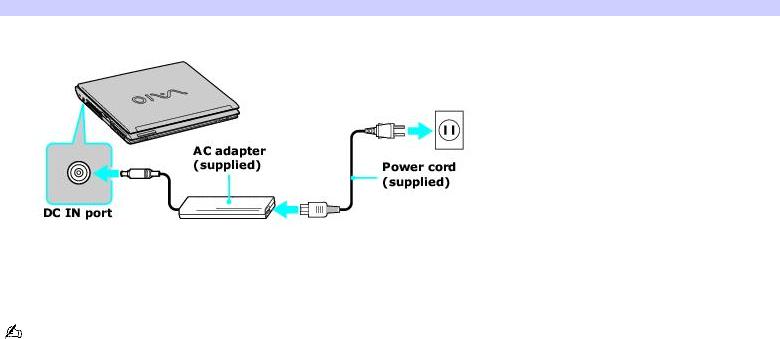
Connecting the AC adapter
To connect the AC adapter
1.Plug the AC adapter cable into the DC IN port.
Connecting the AC Adapter to the Computer
2.Plug the power cord into the AC adapter and an AC outlet.
Use only the supplied AC adapter with your computer.
Page 4
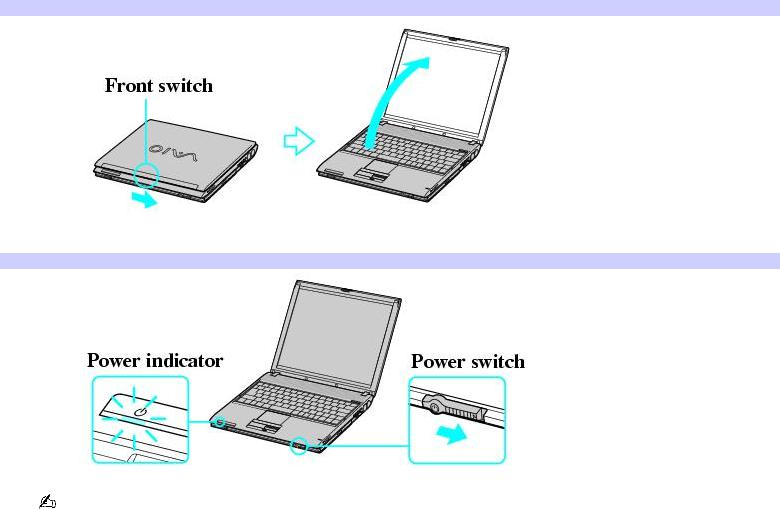
Turning on the computer
To turn on the computer
1.Lift the lid of the computer by sliding the front switch to the right and lifting the lid. You may need to hold the bottom of the computer firmly to lift the lid.
Opening the Computer
2.Slide the power switch to the right until the power indicator turns on.
Turning on the Computer
If you slide and hold the power switch, the computer turns off.
3.If the computer screen is too dark or too bright, follow these steps to adjust the brightness:
To increase brightness, press the Fn and F5 keys, and then press the Up Arrow  or the Right Arrow
or the Right Arrow
 key.
key.
To decrease brightness, press the Fn and F5 keys, and then press the Down Arrow  or the Left Arrow
or the Left Arrow  key.
key.
Page 5

Using the Battery
Your computer, depending on the model you purchased, may come equipped with one battery bay and one multipurpose bay that supports a second battery. If your computer comes with two bays, you can purchase a second rechargeable battery to extend your computing time. For information on how to extend the life of the battery, see Conserving Battery Power for more information.
Inserting a battery
Removing a battery
Locating battery information
Charging a battery
Notes on batteries
Frequently asked questions
 When operating your computer on battery power, your computer's CPU speed is reduced.
When operating your computer on battery power, your computer's CPU speed is reduced.
 The battery that comes with your computer is not fully charged at the time of purchase.
The battery that comes with your computer is not fully charged at the time of purchase.
 The brightness of your computer screen automatically dims when you switch from AC power to battery power. To increase the brightness, press the Fn and F5 keys, and then press the Up Arrow
The brightness of your computer screen automatically dims when you switch from AC power to battery power. To increase the brightness, press the Fn and F5 keys, and then press the Up Arrow  or Right Arrow
or Right Arrow  key.
key.
Page 6

Inserting a battery
To insert a battery
1.Turn the computer over, and slide the LOCK/UNLOCK switch on the bottom of the computer to the UNLOCK position.
2.Align the grooves and tabs on the battery with those on the back of the computer.
Inserting a Battery
3.Slide the battery into the computer until it clicks into place.
4.Slide the LOCK/UNLOCK switch into the LOCK position.
 If a port replicator is attached to your computer, do not insert or remove the battery. Lifting and turning the computer with the port replicator attached could cause a temporary loss of power.
If a port replicator is attached to your computer, do not insert or remove the battery. Lifting and turning the computer with the port replicator attached could cause a temporary loss of power.
Some programs and peripheral devices prevent the system from automatically entering Hibernate mode. If you are using battery power, save your data frequently to avoid data loss and manually activate a power saving mode. See Using power saving modes for more information.
Page 7
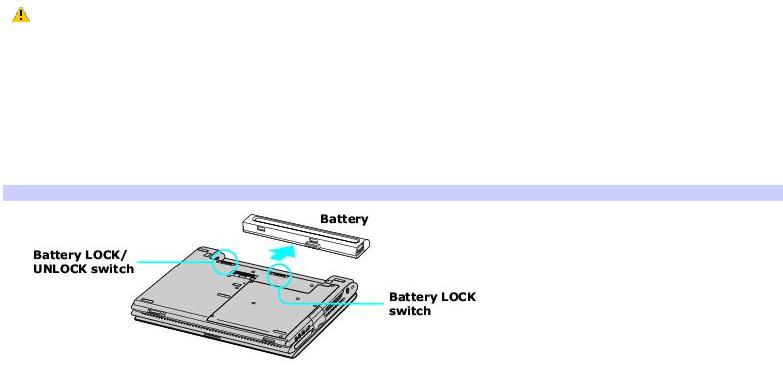
Removing a battery
If you are not using the computer for an extended period of time, remove the battery from the computer to avoid damaging the battery. You can remove the battery when the computer is on or off.
If the computer is on, connect the AC adapter and exit a power saving mode before you remove the battery.
To remove a battery
1.Turn the computer over, and slide the LOCK/UNLOCK switch on the bottom of the computer to the UNLOCK position.
2.Push and hold the UNLOCK switch.
3.While holding the UNLOCK switch, slide the battery away from the computer.
Removing a Battery
Page 8

Locating battery information
You can display information for the battery installed in your computer.
To view battery information
1.Click Start on the Windows® taskbar, and click Control Panel.
2.Click Performance and Maintenance, and click Power Options. The Power Options Properties window appears.
3.Select the Power Meter tab. The total remaining battery charge is listed as a percentage. If your computer comes with more than one battery, you can view information on both batteries or just the primary battery.
 You may also use the power icon on the Windows® taskbar to quickly view battery information. See To display the power icon on the taskbar for instructions on how to set up this shortcut.
You may also use the power icon on the Windows® taskbar to quickly view battery information. See To display the power icon on the taskbar for instructions on how to set up this shortcut.
To display the power icon on the taskbar
1.Click Start on the Windows® taskbar, and click Control Panel.
2.Click Performance and Maintenance, and click Power Options. The Power Options Properties window appears.
3.Select the Advanced tab, and then select Always show icon on the taskbar in the Options box. The power icon appears on the taskbar. See the power icon descriptions below for more information.
You can rollover the power icon to view the remaining battery charge, and you can double-click the power icon to open the Power Meter window, which also displays the remaining battery charge.
Power icon Power status
Computer is using AC power.
Computer is using AC power and charging the battery.
Battery is charging.
Battery is fully charged.
Battery is discharging.
No battery is inserted in the computer.
Page 9
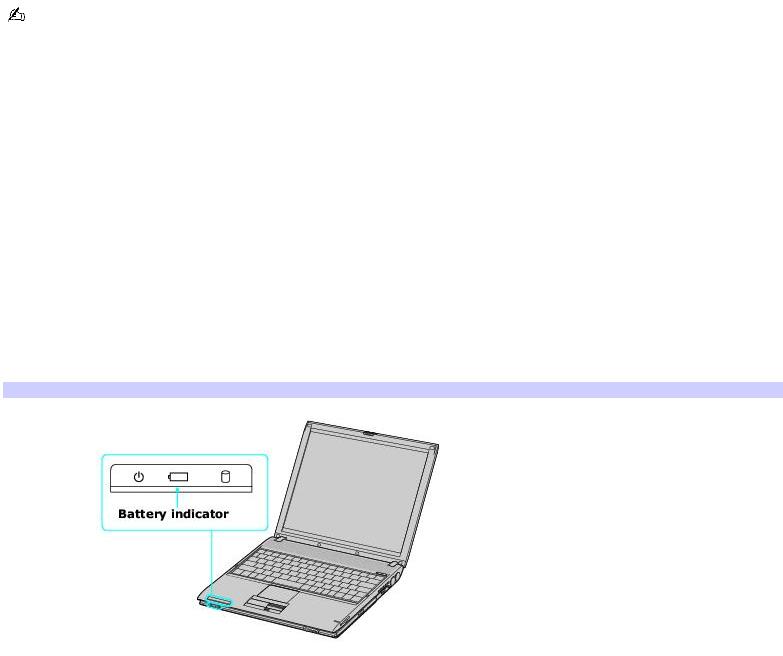
Charging a battery
You will need to charge the battery if battery power drops below 10 percent or you have not used the battery for a long time. The lithium-ion battery supplied with your computer may be recharged at any time, whether you wait until the battery is completely or partially discharged. Charging a partially discharged battery does not affect battery life. If you charge the battery and find that battery power is still low, the battery may be reaching the end of its life, and you may need to replace it.
The battery supplied with your computer is not charged at the time of purchase.
To charge a battery
You can charge the battery when the computer is on or off. However, the battery will charge faster when the computer is off. Charging the battery takes several hours. See your VAIO® Computer Specifications on the Welcome page for the approximate time needed to charge your battery.
 Charge the battery at temperatures between 50°F and 80°F (10°C to 30°C). Lower temperatures require more time to charge.
Charge the battery at temperatures between 50°F and 80°F (10°C to 30°C). Lower temperatures require more time to charge.
1.Insert the battery into the battery bay.
2.Connect the AC adapter to the computer. The computer automatically charges the battery as long as the computer is using AC power.
The battery indicator blinks while the battery charges. The battery indicator stops blinking when the battery is fully charged.
 When using two batteries, the battery you insert first charges first. The second battery you insert begins charging when the first battery is 85 percent charged.
When using two batteries, the battery you insert first charges first. The second battery you insert begins charging when the first battery is 85 percent charged.
Battery Indicators
Battery indicator status |
Description |
On |
The computer is using battery power. |
Single blink |
The battery is running out of power. |
Double blink |
The battery is charging. |
Off |
The computer is using AC power. |
Page 10
Notes on batteries
Never leave the battery in temperatures above 140°F (60°C), such as under direct sunlight or in a car parked in the sun.
While the battery is in use or being discharged, the battery heats up. This is normal and is not cause for concern.
Keep the battery away from all sources of heat.
Keep the battery dry.
Do not open or disassemble the battery.
Do not expose the battery to any mechanical shock.
Battery life is shorter in a cold environment because of decreased battery efficiency at low temperatures.
Page 11
Frequently asked questions
How do I know when the battery is charged?
To determine the remaining battery charge, see Locating battery information.
When is the computer using AC power?
When the computer is directly connected to the AC adapter, it uses AC power, even if a battery is installed.
When should I recharge the battery?
When the battery level falls below 10 percent.
When both the battery and power indicators blink.
When you have not used the battery for a long time.
When should I replace the battery?
If the battery power is still low after charging it, the battery may be reaching the end of its life and should be replaced.
Should I be concerned that the installed battery is warm?
No, it is normal for the battery to be warm when it is powering the computer.
Page 12

Conserving Battery Power
You may use the power saving modes and PowerPanel utility or power schemes to conserve battery power. Conserving battery power may significantly extend your computing time, depending on how you use your computer.
Using power saving modes
Using PowerPanel utility
Frequently asked questions
Page 13
Using power saving modes
In addition to the normal operating mode, which allows you to turn off specific devices, your computer has two distinct power saving modes: Standby and Hibernate. Use the Standby and Hibernate power saving modes to override a power profile setting and initiate immediate action.
Standby — Saves the state of the system and peripheral devices in memory (RAM). Power consumption is reduced to a minimum. The system remains on, and the computer screen (LCD) is off.
Hibernate — Saves the state of the system and peripheral devices to the hard disk. Power consumption is reduced to the lowest possible setting without being completely off. Hibernate mode consumes the lowest level of power. Your computer enters Hibernate mode when the remaining battery charge drops below 5 percent, regardless of the setting you select.
 Since some software programs and peripheral devices prevent the system from entering Hibernate mode, save your data frequently to avoid data loss.
Since some software programs and peripheral devices prevent the system from entering Hibernate mode, save your data frequently to avoid data loss.
To activate Standby mode
1.Press the Fn and Esc keys. The power indicator blinks in this mode.
2.Press any key to return to normal mode.
To activate Hibernate mode
1.Press the Fn and F12 keys, or press the power button and release it immediately. Do not move the computer until the power indicator turns off.
2.Slide the power switch to the right to return to normal mode.
 If the computer does not activate Hibernate mode, see Frequently asked questions for more information.
If the computer does not activate Hibernate mode, see Frequently asked questions for more information.
Page 14

Using PowerPanel utility
The PowerPanel utility enables you to select and customize a predefined power management profile to conserve battery life. The following table describes all the predefined power management profiles in PowerPanel. Your computer is set to Maximum Battery Life by default. You can customize the settings for all the following profiles, except the Disable Power Management profile.
Profile
Icon Description
 Maximum Performance
Maximum Performance
Provides the best system performance but conserves minimal power.
 Maximum Battery Life
Maximum Battery Life
Provides power saving features to give you maximum battery life and good performance. It slows the computer and puts it into Standby mode after a specified time.
Ultimate Battery Life
Extends the Maximum Battery Life by stopping power to the optical drive.
 Power Management Off
Power Management Off
Disables all power management settings, such as Standby and Hibernate modes. You cannot change the settings of this profile.
 AC Power
AC Power
Indicates when AC power is in use. Similar to the Power Management Off setting. Power Management automatically loads the AC profile unless you disable this feature.
 Games
Games
Disables the display and the Hard Disk Standby timer.
 Presentation
Presentation
Keeps the display on at all times while conserving power. This option is ideal for slide show presentations. You can establish settings for LCD (Video) Standby, Hard Disk Standby, and Standby mode to optimize power management for your system.
 Camera
Camera
Optimizes performance and power requirements for camera usage.
DVD
Optimizes performance and power requirements for DVD usage.
 Word Processing
Word Processing
Optimizes power management with longer time-outs on the hard disk and display screen. You can also establish settings for LCD (Video) Standby, Hard Disk Standby, and Standby mode to optimize power management for your system.
 Spreadsheet
Spreadsheet
Optimizes performance and power requirements for spreadsheet programs.
 Communications
Communications
Extends battery life by initiating a quick display time-out. The Internal modem remains powered on. You can also establish settings for LCD (Video) Standby, Hard Disk Standby, and Standby mode to optimize power management for your system.
 Automatic Profile Selection
Automatic Profile Selection
Automatically selects a profile suitable for active software programs. |
Page 15 |
|

Do not choose the Automatic Profile Selection when connected to AC power.
To select a profile
1.Right-click the CPU icon  on the Taskbar Notification area.
on the Taskbar Notification area.
2.Select Profiles, and click the profile name on the shortcut menu. The profile settings are implemented instantly. See Using PowerPanel utility for descriptions of available profiles.
When you use the battery to power your computer, your system automatically selects the Maximum Battery Life power management profile by default. If you select a different power management profile while using battery power, that profile is selected automatically the next time you use the battery to power your computer.
 See PowerPanel Help for information on customizing the power management profiles.
See PowerPanel Help for information on customizing the power management profiles.
To customize your profile settings
You can customize your profile settings to sustain enough power for a particular computing function.
1.Right-click the CPU icon  on the Taskbar Notification area.
on the Taskbar Notification area.
2.Select Edit/Create Profiles from the shortcut menu.
3.In the left panel, select the profile you want to change.
4.Right-click the setting under System, LCD(Video), Hard Disk, or Other Devices that you want to change. See the following table for a description of each power profile.
5.Make your changes from the drop-down menu.
6.Click File, and click Save.
Power profile Description
CPU Control1 Controls the processor speed. You can select either Performance, Adaptive, Battery Life, or More Battery Life. These selections are listed in order from the greatest to least amount of power consumed.
System Standby Timer |
Controls the time it takes the system to activate the Standby mode when it is idle. The longer |
you allow the computer to sit idle while it is not in a power saving mode the more power the computer consumes. |
|
Hibernate Timer |
Controls the time it takes the system to activate the Hibernate mode when it is idle. The longer you |
allow the computer to sit idle while it is not in a power saving mode the more power the computer consumes. Hibernate mode conserves more power than Standby mode.
Thermal Control Strategy1 |
(On selected models) Controls the speed of the processor fan. You can set the fan speed to |
|
Quiet, which conserves the most power, or Performance. |
||
Lid Close Action |
Controls the state of your system when you close the computer's lid. You can select either Standby |
|
or Hibernate mode, or you can select LCD Off. Hibernate or LCD Off conserves the most power. |
||
Hibernate on Low Battery |
Controls the state of your system when the battery power is low. You can turn this setting |
|
On or Off. Selecting On conserves the most power when the battery is low. |
||
LCD Brightness |
Controls the brightness of the computer screen (LCD). You can select a brightness level of one to |
|
nine, with one being the darkest setting. The darker you set the computer screen the more power you conserve. |
||
LCD Standby Timer |
Controls the time it takes the system to turn off power to the computer screen (LCD) when the |
|
system is idle. The system itself still functions on full power.
Page 16
HDD Standby Timer Controls the time it takes the system to turn off power to the hard disk drive when the system is idle. This setting only turns off power to the hard disk drive.
i.LINK Port |
Controls power to the i.LINK® port. Disabling power to the i.LINK port conserves power. |
|
Memory Stick Port Power-saving |
Controls power to the Memory Stick media slot. Disabling power to the Memory Stick |
|
slot conserves power. |
|
|
Optical Drive Power-Saving Controls power to the optical drive. Disabling power to the optical drive conserves power.
1 Slows the processor speed.
Page 17
Frequently asked questions
Can my computer enter Hibernate mode while using battery power?
Your computer can enter Hibernate mode while using battery power, but some software programs and peripheral devices prevent the system from entering Hibernate mode at all. If you are using a program that prevents the system from entering Hibernate mode, save your data frequently. See To activate Hibernate mode for information on how you can manually activate Hibernate mode.
Why doesn't my computer enter Hibernate mode?
You may first need to enable Hibernate mode. Follow these steps:
1.Click Start on the Windows® taskbar, and click Control Panel.
2.Click Performance and Maintenance, and click Power Options. The Power Options Properties window appears.
3.Select the Hibernate tab.
4.Click to check the box next to Enable hibernation.
Page 18

Internet and Network Connections
Internet Connections
Network Connections
Connecting Another VAIO Computer
Page 19

Internet Connections
This section describes the basic steps for setting up your dial-up or Ethernet connection to the Internet. The New Connection Wizard guides you through the process of connecting to the Internet and choosing an Internet service provider (ISP) or setting up an existing account. When you connect to the Internet, you can register your VAIO® computer, use online services, and gain access to Sony Computing Support.
Setting up a dial-up Internet connection
Setting up an Ethernet Internet connection
Customizing your Internet connection
Frequently asked questions
Page 20
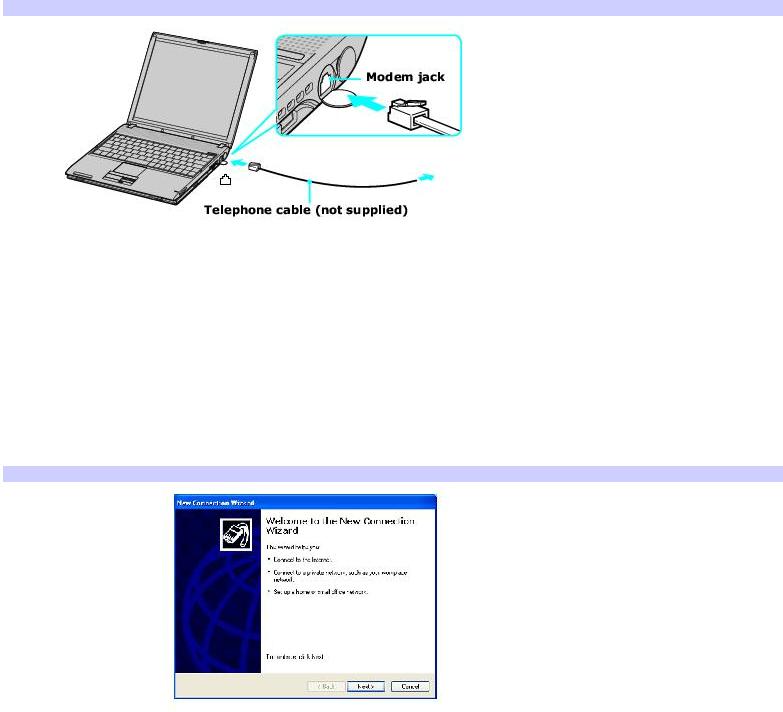
Setting up a dial-up Internet connection
Before you can connect to the Internet, you need to connect your computer to a telephone line via a telephone cable (not supplied). Once you set up your telephone cable, you're ready to connect to the Internet.
To connect a telephone cable
1.Locate the Modem jack on your computer. For location information, see Locating Ports and Controls in the Setting Up chapter of your printed VAIO® Computer Quick Start.
2.Plug one end of the telephone cable into the Modem jack. Make sure it clicks into place.
3.Plug the other end into the wall jack.
Connecting a Telephone Cable
 Your computer does not work with party lines, cannot be connected to a coin-operated telephone, and may not work with multiple telephone lines or a private branch exchange (PBX). Some of these connections may result in excess electrical current and could cause a malfunction in the internal modem.
Your computer does not work with party lines, cannot be connected to a coin-operated telephone, and may not work with multiple telephone lines or a private branch exchange (PBX). Some of these connections may result in excess electrical current and could cause a malfunction in the internal modem.
If you connect a telephone cable coming through a splitter, the modem or connected device may not work properly.
To set up a dial-up connection to the Internet
1.Connect your computer to a telephone line. See To connect a telephone cable for more information.
2.Click Start, point to All Programs, Accessories, Communications, and click New Connection Wizard. The New Connection Wizard appears.
New Connection Wizard
3.Click Next. If the Location Information dialog box appears, follow the on-screen instructions.
4.If it is not already selected, click to select Connect to the Internet, and click Next.
5.Follow the on-screen instructions.
Page 21
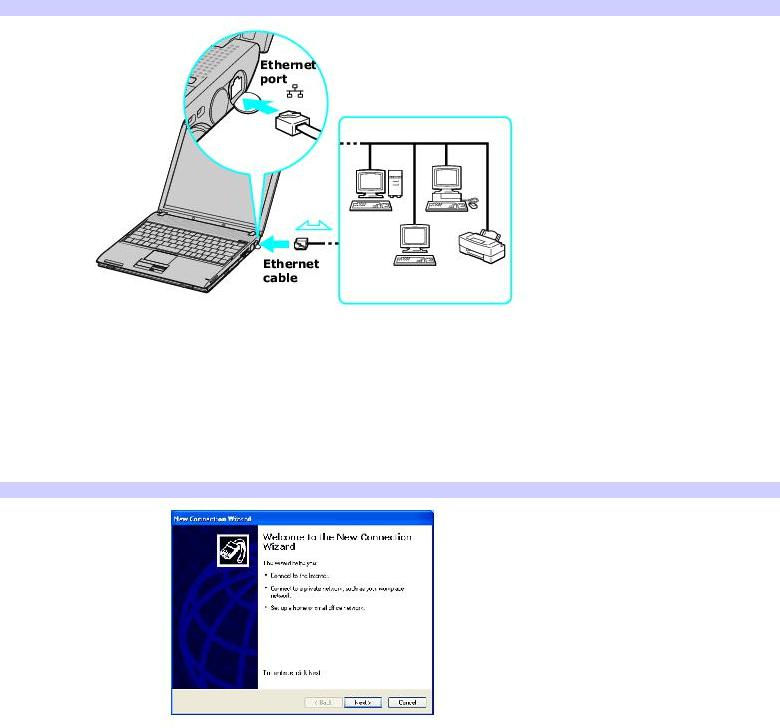
Setting up an Ethernet Internet connection
Your computer accommodates both 10BASE-T and 100BASE-TX Ethernet connections, with data transfer speeds of between 10 and 100 Mbps.
To connect an Ethernet cable
1.Locate the Ethernet port on your computer. For location information, see "Locating Controls and Ports" in the Setting Up chapter of your printed VAIO® Computer Quick Start.
Connecting an Ethernet Cable
2.Plug one end of the Ethernet cable into your computer's Ethernet port  and the other into the network connection.
and the other into the network connection.
To set up an Ethernet connection to the Internet
1.Connect your computer to a network connection.
2.Click Start, point to All Programs, Accessories, Communications, and click New Connection Wizard. The New Connection Wizard appears.
New Connection Wizard
3.Click Next. If the Location Information dialog box appears, follow the on-screen instructions.
4.If it is not already selected, click to select Connect to the Internet, and click Next.
5.Follow the on-screen instructions.
Page 22
Customizing your Internet connection
The Internet Properties dialog box enables you to change the way you view the Internet. You can change your home page, fonts, language, and colors. You can also regulate content and set browsing preferences.
To open the Internet Properties dialog box
1.Click Start on the Windows® taskbar, and then Control Panel.
2.Click Network and Internet Connections, and then Internet Options. The Internet Properties dialog box appears.
3.Click the tabs to view options.
4.Make changes, and click Apply to activate your changes.
5.Click OK.
Page 23
Frequently asked questions
Why doesn't my modem work?
Make sure the telephone cable is securely plugged into the Modem jack on the computer and the wall jack. See To connect a telephone cable for more information.
Make sure the telephone cable is working. Plug the cable into an ordinary telephone and listen for a dial tone.
Make sure the telephone number the program is dialing is correct.
Make sure the software you are using is compatible with the computer's modem. (All preinstalled Sony programs are compatible.)
If you are still experiencing problems, use the supplied Application Recovery CD(s) to reinstall the modem driver software. See Using the Application Recovery CDs for more information.
Why is my modem connection slow?
Your computer is equipped with a V.90 compatible modem. Many factors may influence modem connection speed, including telephone line noise or compatibility with telephone equipment, such as fax machines or other modems. If you think your modem is not connecting properly to other PC-based modems, fax machines, or your Internet Service Provider (ISP), follow these steps:
Ask your telephone company to verify your telephone line is free of any line noise.
If your problem is fax-related, make sure there are no problems with the fax machine you are calling and that it is compatible with fax modems.
If you are having a problem connecting with your ISP, make sure the ISP is not experiencing technical problems.
If you have a second telephone line, try connecting the modem to that line.
Page 24
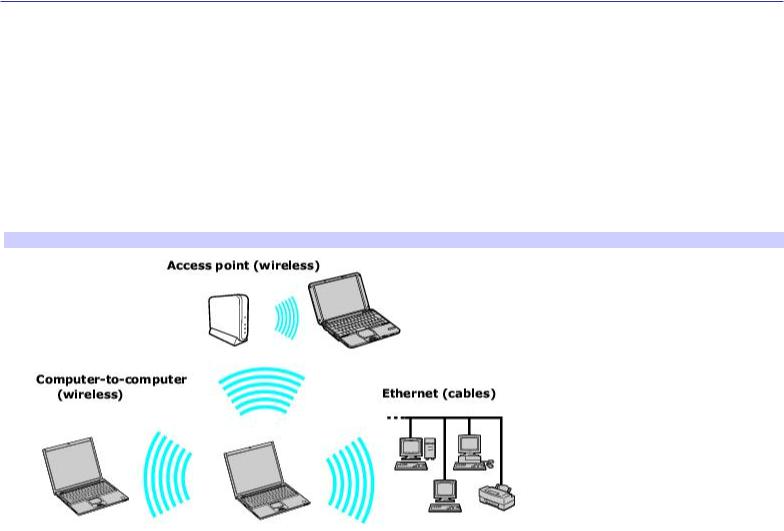
Network Connections
With a Sony computer, you can easily set up or connect to a variety of networks. The New Connection Wizard and Network Setup Wizard make it easy to gain access to remote and local area networks (LANs) using wireless, Ethernet, or dial-up connections.
For more information about networking, click Start, Help and Support, and then Networking and the Web.
Using Ethernet and dial-up connections
Using wireless network connections (selected models only)
Checking your network connection status
Frequently asked questions
Types of Networks*
* The computers represented in this graphic may not be identical to the model you purchased.
Page 25

Using Ethernet and dial-up connections
For setting up local area networks (LANs), Ethernet is a widely installed technology. Your computer accommodates both 10BASE-T and 100BASE-TX Ethernet connections, with data transfer speeds of between 10 and 100 Mbps.
To connect to a local area network using a telephone or Ethernet cable
1.Connect an Ethernet or telephone cable to your computer. See To connect an Ethernet cable and Setting up a dial-up Internet connection for more information.
Connecting an Ethernet Cable
2.Click Start, point to All Programs, Accessories, Communications, and click Network Setup Wizard. The Network Setup Wizard appears.
Network Setup Wizard
3.Click Next. If you are prompted to the Local Information dialog box, follow the on-screen instructions.
 Only connect 10BASE-T and 100BASE-TX cables to the Ethernet port
Only connect 10BASE-T and 100BASE-TX cables to the Ethernet port  . Do not connect any other type of network cable or any telephone cable. Connecting cables other than those listed above may result in an electric current overload and could cause a malfunction, excessive heat, or fire in the port. To connect the unit to the network, see Using Ethernet and dial-up connections or contact your network administrator.
. Do not connect any other type of network cable or any telephone cable. Connecting cables other than those listed above may result in an electric current overload and could cause a malfunction, excessive heat, or fire in the port. To connect the unit to the network, see Using Ethernet and dial-up connections or contact your network administrator.
You can connect to your company network from a remote location and use data, programs, and network resources. See Microsoft® Windows® Help by clicking Help and Support from the Start menu, and then clicking Networking and the Web in the left panel.
To connect to a remote network using a telephone or Ethernet cable
1.Connect an Ethernet or telephone cable to your computer. See To connect an Ethernet cable and Setting up aPage 26
dial-up Internet connection for more information.
2.From the Start menu, point to All Programs, Accessories, Communications, and click New Connection Wizard.
3.Click Next. If you are prompted to the Local Information dialog box, follow the on-screen instructions.
4.Click Connect to the network at my workplace, and then click Next.
5.Follow the on-screen instructions.
6.Ask your network administrator for the detailed settings and devices needed to connect to an existing network.
Page 27
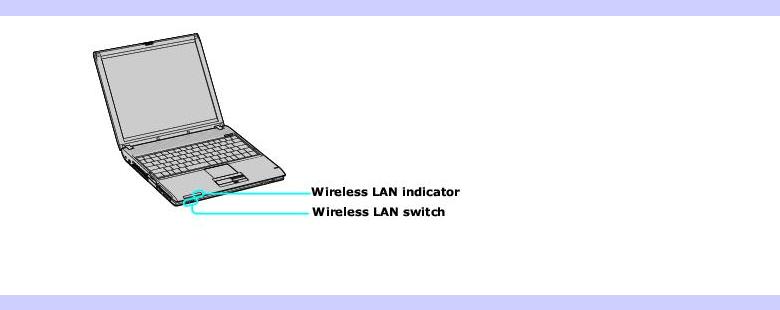
Using wireless network connections (selected models only)
A wireless local area network (LAN) is a network in which you can connect to a LAN through a wireless (radio) connection. You can opt to purchase a Sony Wireless LAN Access Point to set up a LAN.
The wireless LAN access point is designed for building a wireless LAN environment. Because a wireless LAN configuration requires no wiring, you can operate multiple computers more freely than ever before.
Your computer is equipped with a built-in mini PCI card that allows for wireless connections. For information about your computer's wireless capabilities, see the Welcome page to view your VAIO® Computer Specifications.
 For more information on Sony Wireless LAN, go to http://www.sonystyle.com/vaio.
For more information on Sony Wireless LAN, go to http://www.sonystyle.com/vaio.
There are two types of wireless connections:
An infrastructure network is one that extends an existing wired local network to wireless devices by providing an access point. The access point bridges the wireless and wired LAN and acts as a central controller for the wireless LAN. The access point coordinates transmission and reception from multiple wireless devices within a specific range.
A computer-to-computer (ad-hoc) network is one in which a local network is created only by the wireless devices themselves, with no other central controller or access point. Each device communicates directly with other devices in the network. You can set up an ad-hoc network easily at home.
To connect to a wireless network
1.Make sure an access point is set up. See the instructions that accompanied the access point for more information.
2.Move the Wireless LAN switch to ON.
Turning on the Wireless Network Switch
3.Click the Wireless Network Connection icon  on the taskbar. The Wireless Network Connection dialog box appears.
on the taskbar. The Wireless Network Connection dialog box appears.
Wireless Network Connection Dialog Box
Page 28
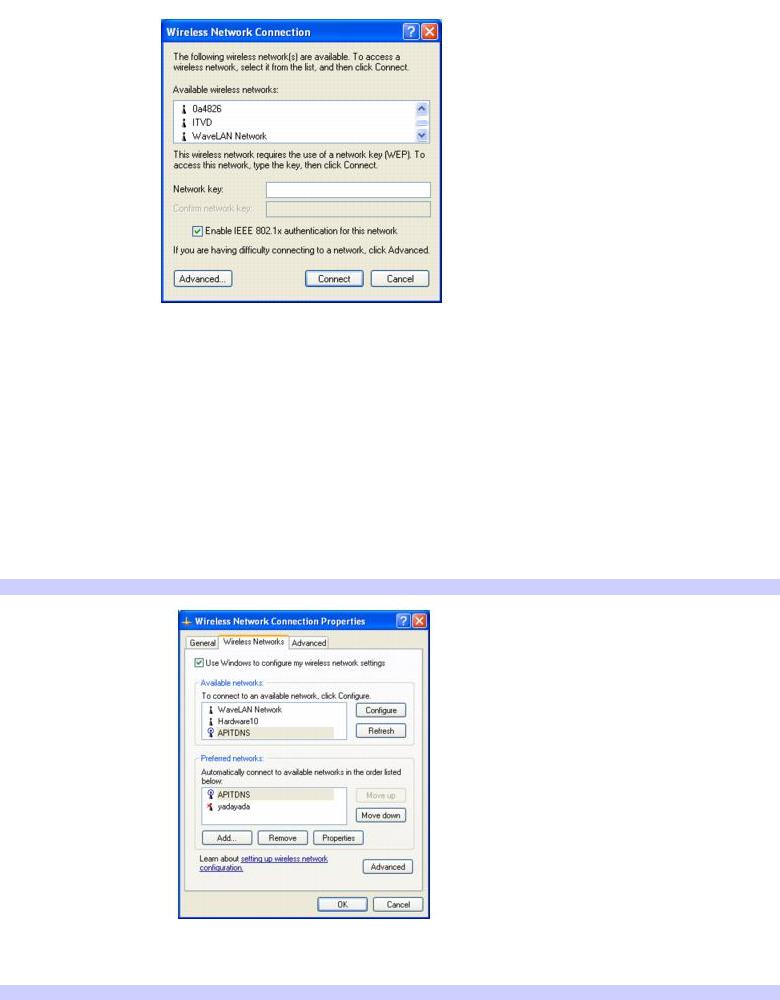
4.From the Available wireless networks list, select the name of the network (access point) in which you want to connect. If you do not see the network name, see If the network does not appear in the Available wireless networks list box.
5.If required, type the network key in the Network key box. (If necessary, ask the administrator for the key. The key should be between 5 and 13 ASCII characters or 10 to 26 hexadecimal characters.)
6.Retype the network key in the Confirm network key box.
7.Click Connect.
If the network does not appear in the Available wireless networks list box
1.Click Advanced on the Wireless Network Connection dialog box. The Wireless Network Connection Properties dialog box appears.
Wireless Network Connection Properties Dialog Box
2.Click Add in the Preferred networks box. The Wireless network properties dialog box appears.
Wireless Network Properties dialog box
Page 29
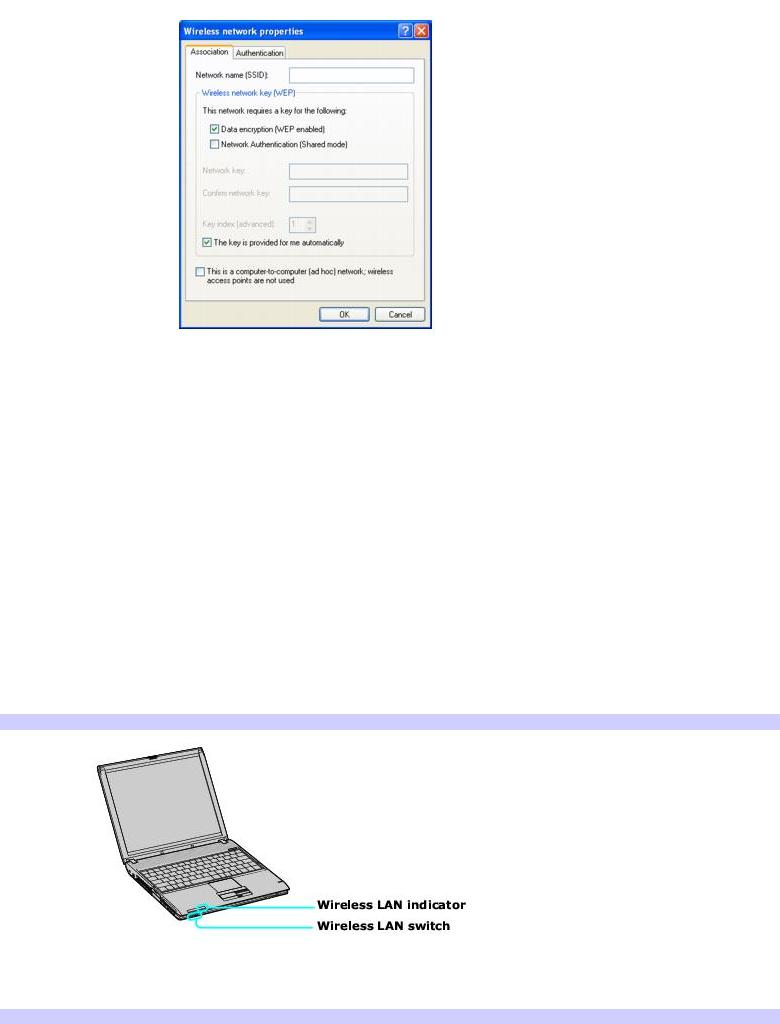
3.Type the name of the network (access point) you want to connect to in the Network name (SSID) box. (The name should be no more than 32 ASCII characters.)
 The following steps are for networks that require a network key. If you do not know the network key or are not sure a network key is required, see the network administrator or the guide that accompanied your access point for more information.
The following steps are for networks that require a network key. If you do not know the network key or are not sure a network key is required, see the network administrator or the guide that accompanied your access point for more information.
4.Make sure the Data encryption (WEP enabled) check box is selected.
5.Click to cancel the The key is provided for me automatically check box.
6.Type the network key in the Network key box. (The key should be between 5 and 13 ASCII characters or 10 to 26 hexadecimal characters.)
7.Retype the network key in the Confirm network key box.
8.Click OK. The network name appears in the Preferred networks list box.
To set up a computer-to-computer (ad-hoc) network
1.Move the Wireless LAN switch to ON.
Turning on the Wireless Network Switch
2.Click the Wireless Network Connection icon  on the taskbar. The Wireless Network Connection dialog box appears.
on the taskbar. The Wireless Network Connection dialog box appears.
Wireless Network Connection Dialog Box
Page 30
